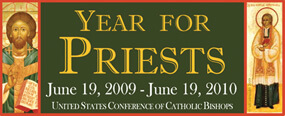 Serving at the Pontifical North American College in Rome, I have the privilege of living with priests and seminarians from all over our country. Currently, we have a house of more than 200 seminarians and 70 priests from all across our land. In addition, the city of Rome has a wide variety of national colleges from around the world, our American College just being one of many.
Serving at the Pontifical North American College in Rome, I have the privilege of living with priests and seminarians from all over our country. Currently, we have a house of more than 200 seminarians and 70 priests from all across our land. In addition, the city of Rome has a wide variety of national colleges from around the world, our American College just being one of many.
The seminarians and priests of these different national colleges attend university lectures together each day, in very international settings, at primarily the Gregorian University (Jesuits) and the Angelicum University (Dominican). Both the priest professors and the student priests and seminarians come from literally all the continents of the world.
Rome also hosts a wide variety of religious communities serving various pastoral needs in Rome and beyond, while also many times serving as houses of formation for their own communities. In addition, of course, Pope Benedict XVI lives here too and his ministry as the Bishop of Rome, as St. Peter’s successor, is the root of universality.
Living in Rome is a loud, ever present, daily reminder that the priesthood is not defined by any one culture nor historical period, but rather encompasses all these cultures in a mysterious and beautiful way and unites them through the mission of the priest.
The ultimate source of unity for all priests is their identity in Jesus Christ. Jesus is the high priest, sent by the Father to offer the sacrifice for God’s people, ushering in the new kingdom. In turn, Jesus will send his apostles into all the world, to make disciples of all nations and to make present that sacrifice of Christ.
Priests can find their identity in the high priestly prayer of Jesus to the Father, recounted in John’s Gospel in which Jesus is the high priest acting on behalf of his people. This prayer sheds light on each priest’s mission and connects it to that of Jesus’ own mission, uniting priests in their common identity as they both offer the sacrifice and become a sacrifice themselves by laying down their lives in service.
Our Lord prays to His Father in Heaven as His disciples listen, “As you sent me into the world, so I send them into the world.” Pope Benedict once wrote about this “sending,” “Jesus appears as the bearer of a power received from God. He is ‘sent’ on a mission that is assigned him by the Father. After the resurrection, the office of the apostles takes over this mission, as they are sent by Christ Himself. Therefore, just as St. John says Jesus would do nothing by Himself without the Father, for they are one, so the Apostles can do nothing without Jesus, for they are one in His mission.”
The priest, no matter what country he lives in, what language he speaks, what his personality is, no matter what his sacred ministry, is sent to carry on the mission of Christ. When the first priests were sent by our Lord, St. Matthew tells us that they were told to go into all nations and make disciples. The Gospel message was to be preached to all peoples, and hence the ministers of the Gospel would be throughout the world too. Although priests come from all different countries, with differing personalities, gifts, talents and physical traits, they all participate in the one priesthood of Christ and His one great sacrifice. The mission of the priest goes beyond any particular place where he is assigned and serving, as his mission is tied ultimately to the universal mission of the Church in announcing the Good News to the ends of the earth.
The Year for Priests provides many opportunities for us to be reminded of the universality of the priesthood as we remember in prayer the 408,000 priests in our world today.
Father Checcio is the rector of the Pontifical North American College in Rome.


